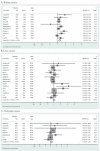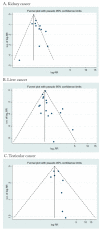Per- and Poly-fluoroalkyl Substances (PFAS) Exposure and Risk of Kidney, Liver, and Testicular Cancers: A Systematic Review and Meta-Analysis
- PMID: 37878255
- PMCID: PMC10627102
- DOI: 10.23749/mdl.v114i5.15065
Per- and Poly-fluoroalkyl Substances (PFAS) Exposure and Risk of Kidney, Liver, and Testicular Cancers: A Systematic Review and Meta-Analysis
Abstract
Introduction: Per- and poly-fluoroalkyl substances (PFASs) are a large, complex group of synthetic chemicals humans can be exposed to from occupational or environmental sources. In this systematic review and meta-analysis, we examined the association between PFAS exposure, particularly Perfluorooctanoic Acid (PFOA), and Perfluorooctane Sulfonic Acid (PFOS), and risk of kidney, liver, and testicular cancer.
Methods: We systematically searched PubMed to identify cohort and case-control studies reported after the Monograph of the International Agency for Research on Cancer and the Toxicological Profile of the Agency for Toxic Substances and Disease Registry. We assessed the quality of the studies by using a modified version of the Newcastle-Ottawa Scale (NOS). Forest relative risk (RR) plots were constructed for liver, kidney, and testicular cancer. We conducted stratified analyses by geographic region, study design, quality score, outcome, years of publication, exposure source, and PFAS type. A random-effects model was used to address heterogeneity between studies.
Results: Fifteen studies, including ten cohort studies, three case-control studies nested in a cohort, and two case-control studies were included after removing duplicate and irrelevant reports. We found an association between overall PFAS exposure and the risk of kidney cancers (RR=1.18, 95% CI =1.05-1.32; I =52.8%, 11 studies). Also, we showed an association between high-level exposure to PFAS and kidney cancer (RR=1.74, 95% CI =1.23-2.47; p=0.005) and testicular cancer (RR=2.22, 95% CI =1.12-4.39; p=0.057). There was no association with liver cancer. We found no heterogeneity by geographical region, PFAS type, study design, outcome, quality score, year of publication, or exposure source. Only two studies reported results among women.
Conclusions: We detected an association between overall PFAS exposure and kidney cancer and high doses of PFAS with testicular cancer. However, bias and confounding cannot be excluded, precluding a conclusion in terms of causality.
Conflict of interest statement
PB acted as an expert in litigation involving PFAS exposure unrelated to the present work. MSS declares no conflict of interest.
Figures



Similar articles
-
Per- And Poly-Fluoroalkyl Substances (PFAS) Exposure and Risk of Breast, and Female Genital Cancers: A Systematic Review and Meta-Analysis.Med Lav. 2024 Dec 19;115(6):e2024043. doi: 10.23749/mdl.v115i6.16330. Med Lav. 2024. PMID: 39697081 Free PMC article.
-
Per- and poly-fluoroalkyl substances (PFASs) in follicular fluid from women experiencing infertility in Australia.Environ Res. 2020 Nov;190:109963. doi: 10.1016/j.envres.2020.109963. Epub 2020 Jul 21. Environ Res. 2020. PMID: 32745751
-
Systematic review and meta-analysis of epidemiologic data on vaccine response in relation to exposure to five principal perfluoroalkyl substances.Environ Int. 2023 Feb;172:107734. doi: 10.1016/j.envint.2023.107734. Epub 2023 Jan 7. Environ Int. 2023. PMID: 36764183
-
Associations between per- and polyfluoroalkyl substances (PFAS) and diabetes in two population-based cohort studies from Sweden.J Expo Sci Environ Epidemiol. 2023 Sep;33(5):748-756. doi: 10.1038/s41370-023-00529-x. Epub 2023 Mar 24. J Expo Sci Environ Epidemiol. 2023. PMID: 36964247 Free PMC article.
-
Breast cancer risk and serum levels of per- and poly-fluoroalkyl substances: a case-control study nested in the California Teachers Study.Environ Health. 2018 Nov 27;17(1):83. doi: 10.1186/s12940-018-0426-6. Environ Health. 2018. PMID: 30482205 Free PMC article.
Cited by
-
Per- and poly-fluoroalkyl substances exposure and risk of gastrointestinal cancers: a systematic review and meta-analysis.Eur J Cancer Prev. 2025 Sep 1;34(5):445-455. doi: 10.1097/CEJ.0000000000000935. Epub 2024 Dec 9. Eur J Cancer Prev. 2025. PMID: 39648934 Free PMC article.
-
Behavioral risk factors in oncology patients: A matched case control study from Yemen.PLoS One. 2025 Aug 7;20(8):e0329534. doi: 10.1371/journal.pone.0329534. eCollection 2025. PLoS One. 2025. PMID: 40773497 Free PMC article.
-
The evolution of PFAS epidemiology: new scientific developments call into question alleged "probable links" between PFOA and kidney cancer and thyroid disease.Front Public Health. 2025 Apr 9;13:1532277. doi: 10.3389/fpubh.2025.1532277. eCollection 2025. Front Public Health. 2025. PMID: 40270749 Free PMC article. Review.
-
Awareness and prevalence of testicular cancer among German firefighters.World J Urol. 2025 Apr 11;43(1):222. doi: 10.1007/s00345-025-05622-4. World J Urol. 2025. PMID: 40214802
-
Per- And Poly-Fluoroalkyl Substances (PFAS) Exposure and Risk of Breast, and Female Genital Cancers: A Systematic Review and Meta-Analysis.Med Lav. 2024 Dec 19;115(6):e2024043. doi: 10.23749/mdl.v115i6.16330. Med Lav. 2024. PMID: 39697081 Free PMC article.
References
-
- Gaines LGT. Historical and current usage of per- and polyfluoroalkyl substances (PFAS): A literature review. Am J Ind Med. 2023;66:353–378. - PubMed
-
- Exner M, Färber H. Perfluorinated surfactants in surface and drinking waters. Environ Sci Pollut Res. 2006;13:299–307. - PubMed
-
- European Environment Agency. Emerging chemical risks in Europe – PFAS. Copenhagen, EEA, 2019. 2019 https://www.eea.europa.eu/themes/human/chemicals/emerging-chemical-risks....
Publication types
MeSH terms
Substances
Supplementary concepts
LinkOut - more resources
Full Text Sources
Medical

